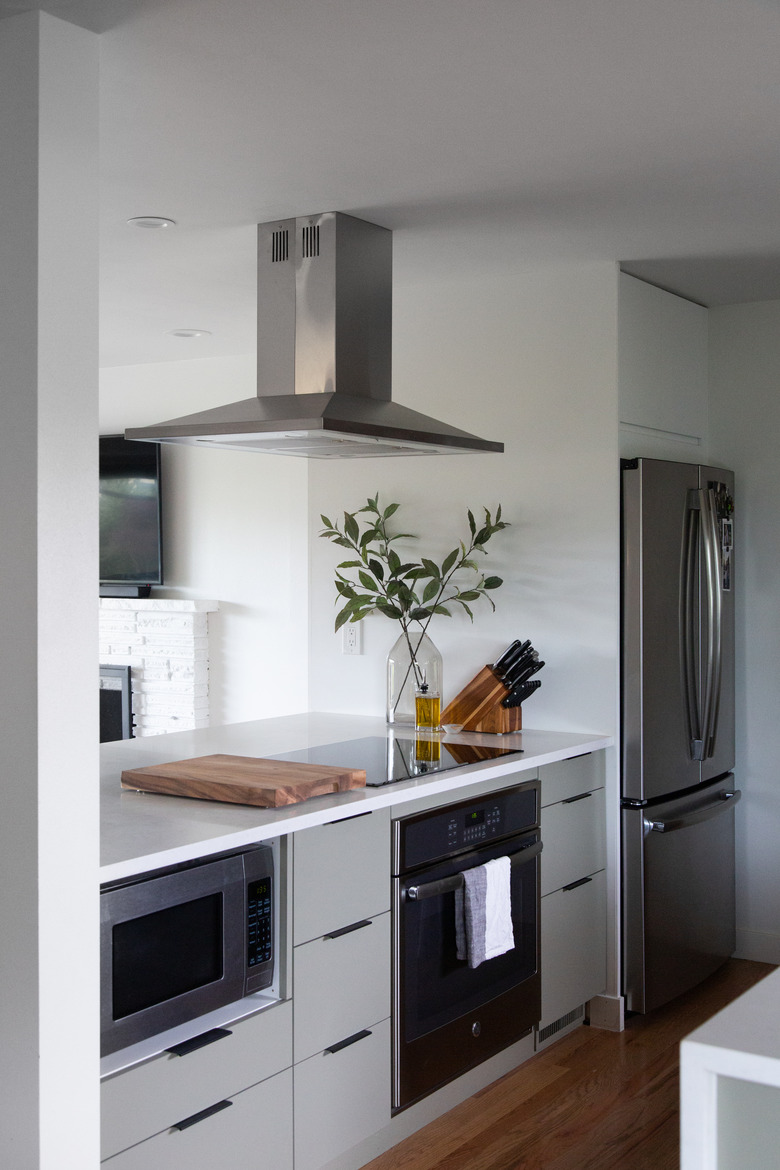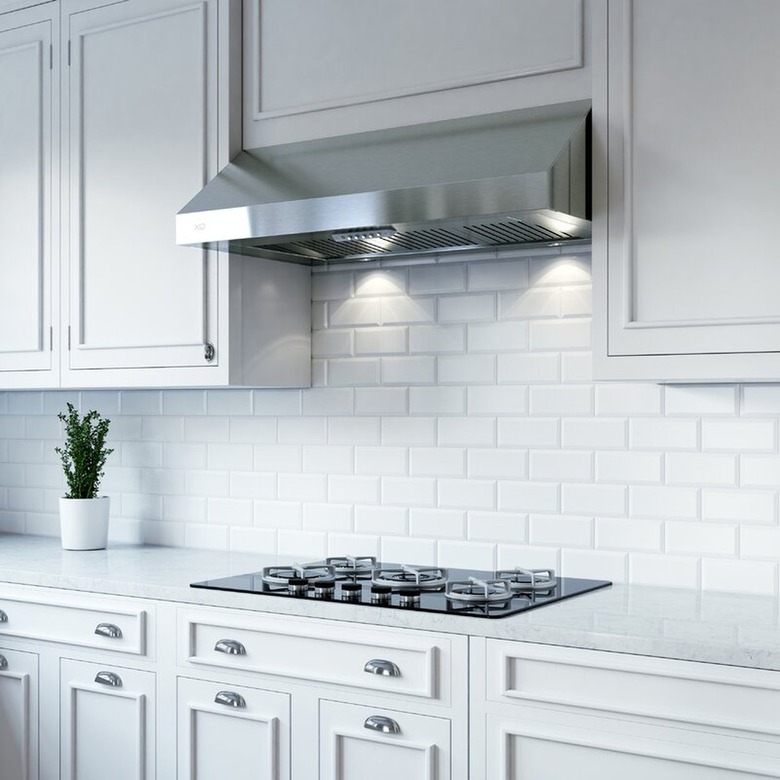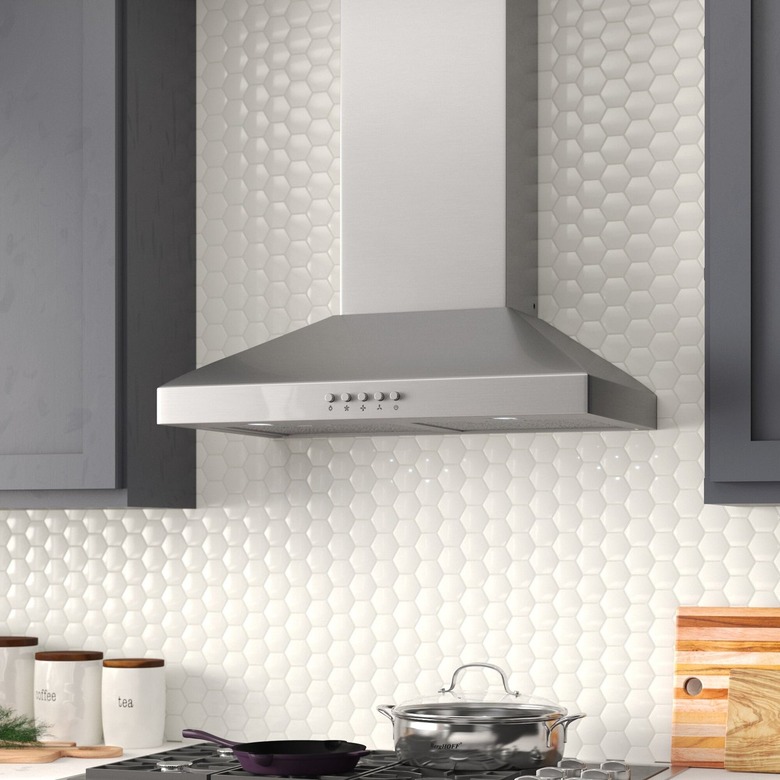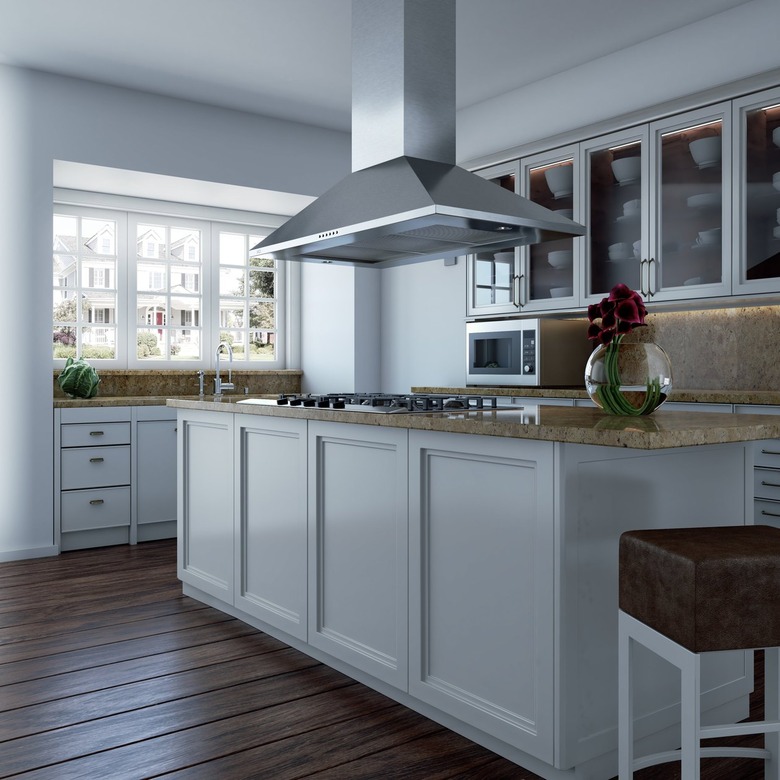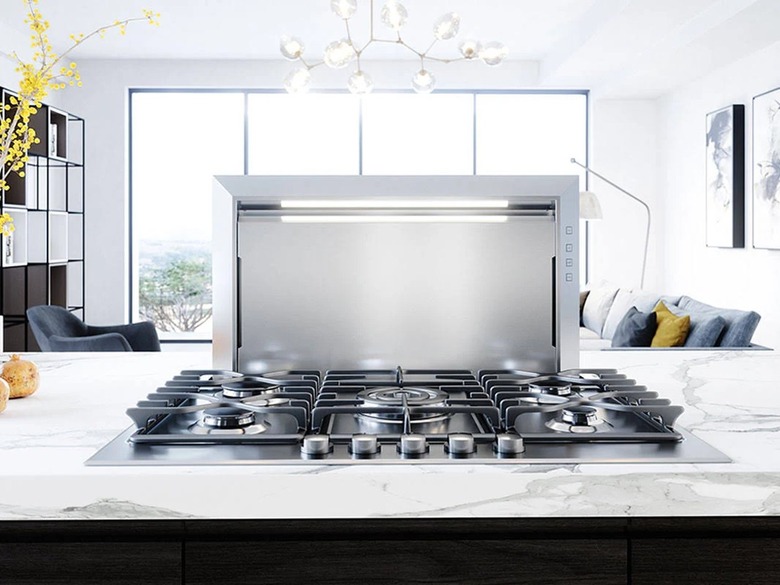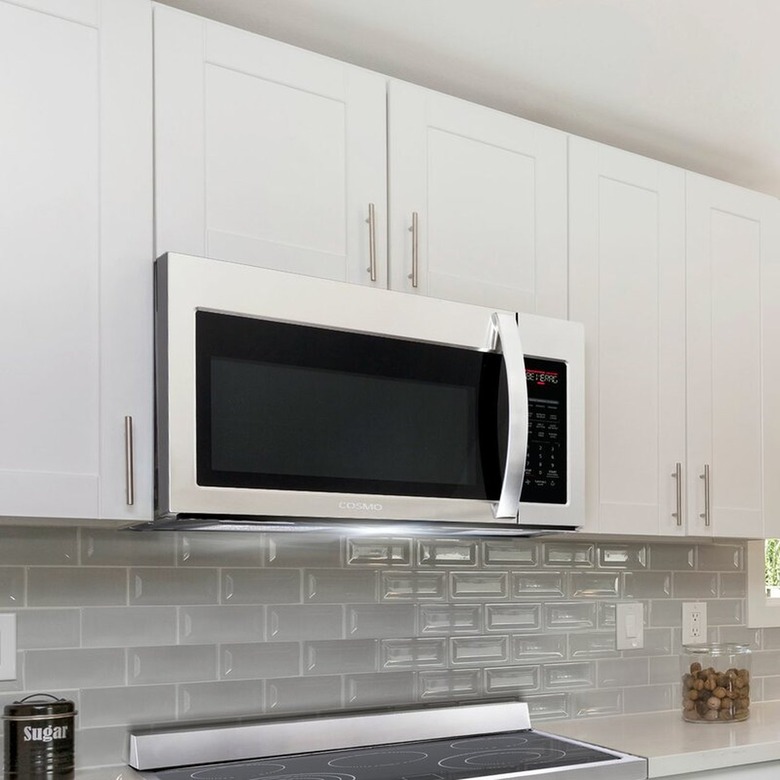Kitchen Ventilation: What You Should Know
We may receive a commission on purchases made from links.
Although often overlooked, kitchen ventilation is more important than most homeowners realize. The kitchen is known as the room where wonderful cooking smells abound, but where there is the aroma of delicious food cooking, it's very likely that less pleasant fumes are also present, leading to poorer indoor air quality. Carbon monoxide fumes from burning natural gas may be present as well as carcinogenic tars and aldehyde compounds. Excess moisture from boiling water or simmering soups can quickly fill your kitchen, and even a simple task, like frying an egg, releases toxic hydrogen sulfide gas into the air.
Understanding the mechanisms of kitchen ventilation and the importance of a quality exhaust hood will keep your kitchen safe and full of only good fumes.
Defining Kitchen Ventilation
Defining Kitchen Ventilation
The answer to ensuring optimal air quality in your kitchen is to provide adequate ventilation. It's important to understand that a home ventilation system, whether it involves a kitchen exhaust fan, bathroom exhaust fan or whole-home air-exchange system, involves two related functions: removing unhealthy vapors and fumes from the home and introducing fresh air to replace what has been removed.
Most homes are somewhat leaky by nature so that any air expelled by a kitchen or bathroom exhaust fan is readily replaced by air that gets sucked in through small gaps around windows and doors. It can be more problematic in tightly sealed, energy-efficient new homes, where an overpowered exhaust fan in the bathroom or kitchen can create a partial vacuum that can prevent furnace or water heater exhaust fumes from exhausting properly, a condition known as backdrafting.
Kitchens must meet the ventilation requirements set forth by ASHRAE standard 90.1-2010. ASHRAE (American Society of Heating, Refrigerating, and Air-Conditioning Engineers) is an organization that sets forth professional standards for mechanical systems. In the case of a kitchen ventilation system, standard 90.1-2010 limits the capacity of a kitchen vent fan so that it cannot create a dangerous vacuum in the home. When buying a kitchen hood, make sure the exhaust fan meets this standard.
Kitchen Ventilation Requirements
Kitchen Ventilation Requirements
You might expect there to be universal code requirements for providing ventilation in a kitchen, but in fact, the requirements vary considerably from state to state and community to community. In one location, it might be allowable for a single operating window to serve the minimum requirements for kitchen ventilation, while another community may require a mechanical exhaust fan of a prescribed size that is vented to the outdoors. However, these are the most typical requirements used in most locales:
- All cooking surfaces, including stove tops and range tops, require a hooded exhaust fan rated for at least 100 cubic feet per minute (cfm).
- Vent hoods rated for more than 400 cfm must have some means of providing makeup air — a fresh air intake that prevents the exhaust fan from creating a partial vacuum in the home that could potentially cause backdrafting of exhaust gases from other fuel-burning appliances. This is usually not a problem unless you are installing a commercial-grade vent hood.
- Vent fans should be ducted to the outdoors through a side wall or through the roof. Ductless "recirculating" exhaust fans, although allowed in some jurisdictions, are poor substitutes for exhaust fans vented to the outdoors.
- Ducts on range hoods must include a mechanical damper that closes over the duct when air is not blowing through it. In side-wall venting, this can be a damper on the vent cap itself. In roof vents, the damper is usually fitted into the ductwork.
- Ductwork must be made of smooth-walled metal. An exception is a duct for a down-draft range hood that runs beneath a concrete slab, which may be made of PVC plastic.
- Plug-in electrical connections are allowed for range hoods if the appliance plugs into its own dedicated circuit, such as with microwave ovens with integrated vent fans. Otherwise, the range hood fan must be hardwired into a kitchen circuit.
In most kitchens, then, kitchen ventilation is provided by a vent hood with an exhaust fan or by an above-the-counter microwave that has a built-in vent fan. Either way, these vent fans should be installed so they are directly above the stove top, where they can most effectively direct fumes to the outdoors. Older kitchens are sometimes fitted with simple ceiling-mounted vent fans that are similar to those used in bathrooms, but these do not provide very effective ventilation and are almost never used in new remodels.
Ventless (Self-Ventilating) Exhaust Fans
Ventless (Self-Ventilating) Exhaust Fans
At one time, appliance manufacturers touted vent hoods and venting microwave ovens that were described as ductless, recirculating, ventless or self-ventilating. These appliances had simple recirculating fans fitted with filters designed to trap grease and particles, but they did nothing to actually exhaust dangerous fumes, such as carbon monoxide. They were nearly useless if the filters weren't kept clean.
This arrangement is no longer considered adequate unless the kitchen also has another exhaust fan vented to the outdoors. While you can still buy vent hoods that can be installed so they are self-venting, most of these can also be adapted to external venting, which is the preferred method.
Vent Hood Sizes
Vent Hood Sizes
The official requirement for a kitchen vent fan is that it must move a minimum of 100 cfm and no more than 400 cfm unless there is a method of introducing makeup air to replace the exhausted air. A range of 100 to 400 cfm is fairly broad, so more guidelines are needed to determine the proper size for a vent fan. There are two calculation methods commonly used to determine the proper size for the kitchen vent fan:
- Stove-top size: The vent hood fan should move 100 cfm of air for each 12 inches of stove width. A 3-foot-wide stove, then, requires a 300 cfm fan in the vent hood.
- Room size: Some designers follow a rule that dictates that a vent fan should be able to move an air volume equal to the volume of the room 15 times per hour, or once every four minutes. Thus, a small 10 x 10-foot kitchen with an 8-foot-high ceiling (which has a volume of 800 cubic feet) requires a vent fan that moves 800 cubic feet every four minutes, or 200 each minute. A 200 cfm vent fan meets this need.
Types of Vent Hoods
Types of Vent Hoods
Whether you have a kitchen island, a small kitchen space, a gas range or other special configurations in your kitchen, there are several types of range hoods from which to choose. Typically, kitchen vent hoods are made in a variety of materials and styles, including stainless steel, bronze, copper, tempered glass, silver, zinc, wood, aluminum, brass and even heat-resistant plastics.
Undercabinet Vent Hood
Undercabinet vent hoods mount to the bottom of a specially designed wall cabinet that contains the ductwork running out through a side wall or up through a soffit and ultimately through the roof. This is a traditional type of vent hood found in many kitchens.
Wall-Chimney Vent Hood
This is a large hood with no cabinetry above it, often used with commercial-grade kitchen ranges. A wall-chimney vent hood can vent through a side wall or through the roof.
Island Vent Hood
Because they hang down from the ceiling and do not mount against a wall, island hoods are finished on all sides. They are used to vent an island cooktop up through the roof or through a floor-joist cavity and then laterally out through a side wall.
Downdraft Vent Hood
When the cooktop is located on an island or peninsula or where there is a large window behind the cooktop, there may be no direct route through a side wall or roof. For this application, there are downdraft vent hoods with powerful fans that suck cooking vapors and kitchen exhaust fumes downward into ductwork that runs beneath the floor and out through a side wall. These are typically quite powerful exhaust fans since the ductwork may be long and have multiple bends, but they do not exhaust as efficiently as overhead venting systems.
Over-the-Range Microwave With Vent Fan
As a space-saving innovation, a variety of microwave ovens with integrated exhaust fans are available. These appliances are generally mounted above the stove or cooktop and are marketed as "over-the-range" or "built-in" microwave ovens. Some types can be configured as either ductless or ducted exhaust fans. The exhaust capacity of these units is typically 200 to 400 cfm, which is sufficient for most kitchens. They usually have built-in filters and lighting fixtures.
Kitchen Ventilation: Basic Installation Process
Kitchen Ventilation: Basic Installation Process
Precise installation procedures vary by manufacturer and model, but the general method for a vent hood follows the same process:
- Plan the ductwork route. It is always best to choose the shortest, most direct route possible to the outdoors. Short ductwork with few bends will create a smooth pathway for the airflow, making the fan more efficient. Long ductwork may compromise the efficiency of the fan, requiring that you install a larger fan to make up for the difference. Make sure to check the pathway for obstructions, such as plumbing pipes, electrical wires, etc. This may require cutting small inspection holes in walls or ceilings to probe the spaces with a small wire.
- Cut holes in cabinets, walls, the ceiling or the roof for running the ductwork. This is best done with a jigsaw or reciprocating saw. Make sure you are prepared to complete the job once you start working since you don't want to leave open holes in your exterior walls or roof.
- Install a roof cap or wall cap. Your ductwork will terminate in a vent cap on the exterior side wall or roofline, so the first step in duct installation is to install the metal or plastic vent cap where the ductwork will terminate. The vent cap has a metal sleeve that extends through the wall or roof and to which the interior ductwork will be attached.
- Run ductwork. Assemble and attach smooth-walled ductwork to run from the roof cap or wall cap to the vent hood location. Avoid using flexible, accordion-style ductwork, as the interior surfaces will collect grease. The best choice is to assemble the ductwork with lengths of smooth metal ducts and elbows assembled with sheet-metal screws. Ductwork can either be rectangular or round in shape depending on where you are running the ductwork. Seal the seams with foil HVAC tape rated for high heat.
- Install the vent hood. Next, mount the vent hood in place following the manufacturer's directions. This can involve simply screwing the vent hood to the wall or to the bottom of a wall cabinet or setting an over-the-range microwave oven on cleats mounted between adjoining wall cabinets.
- Make the final connections. Join the ductwork to the duct outlet on the vent fan. In many cases, this requires a transition duct since the outlet on the vent fan may be rectangular, but the ductwork leading to the outdoors is round. Hardwire the fan to an appropriate household electrical circuit (per the manufacturer's instructions) or plug in the fan as applicable.
Kitchen Ventilation: Considerations and Expert Tips
Kitchen Ventilation: Considerations and Expert Tips
For a good installation and efficient operation, follow these tips:
- Never vent exhaust fan ductwork into an attic. Kitchen exhaust fans must be vented to the outdoors.
- In colder climates, insulate the portion of the ductwork that runs through an attic or other unheated space. This will help minimize condensation inside the duct in winter.
- Where possible, always use smooth-walled ductwork for your vent fan. So-called "semirigid" ductwork, while often permitted by code, is not as good as rigid, smooth-walled, round or rectangular ducts. Never use flexible ductwork with corrugated inner surfaces. This ductwork will trap grease and may even pose a fire hazard.
- Clean filters regularly. Most vent hoods have built-in filters, and once grease and residue build up on the filters, airflow is blocked, so be sure to clean or replace filters monthly.
- Use the vent fan whenever you cook. Surprisingly often, cooks don't bother to use the vent fan at all when cooking. Get into the habit of turning on the fan whenever the stove or oven is operating.

